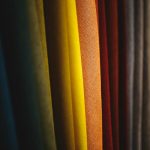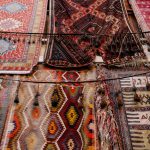You might be surprised to learn that taffeta, often seen as a relic of past fashion, is making a comeback in the textile industry. As designers pivot towards sustainability, this luxurious fabric is being reimagined with eco-friendly fibers and innovative dyeing techniques. Its unique ability to combine structure with elegance could redefine its place in modern fashion. But what does this mean for consumers who value both style and sustainability? The answer might just reshape your perspective on this classic fabric.
Table of Contents
The History of Taffeta
Taffeta has roots that trace back to ancient Persia, where it was first woven from silk to create luxurious garments. You'll find that this fabric has been prized for its crisp texture and elegant finish, making it a favorite among the nobility. As you explore its history, you'll see that taffeta was introduced to Europe during the Middle Ages and quickly became synonymous with opulence.
In the 16th century, it gained popularity in Italy and France, often used in elaborate gowns and decorative furnishings. You might be surprised to learn that its name comes from the Persian word 'taftah,' which means 'twisted woven.' This speaks to the intricate technique employed in its production.
By the 19th century, taffeta evolved further with the introduction of synthetic fibers, enabling wider accessibility while maintaining its luxurious appeal. Throughout the years, you could observe taffeta being used in everything from wedding dresses to evening gowns, reflecting its versatility.
Despite the rise of new fabrics, taffeta's historical significance endures, making it a staple in the textile industry. Its rich heritage and elegant properties continue to captivate those who appreciate fine fabrics.
Current Trends in Taffeta
In recent years, designers have embraced taffeta for its unique ability to create volume and structure in modern fashion collections. You'll find taffeta playing a pivotal role in evening gowns and formal dresses, where its crisp texture adds a dramatic flair. The fabric's lightweight nature allows for effortless movement while retaining an eye-catching silhouette.
You might notice bold colors and metallic finishes making a splash, as designers experiment with taffeta to create striking visual effects. This trend appeals to consumers seeking statement pieces that stand out in today's fashion landscape. Taffeta's sheen also complements layered looks, making it ideal for structured blouses and skirts.
Moreover, you can't ignore the resurgence of retro-inspired designs, where taffeta brings a nostalgic vibe to contemporary styles. This fusion of past and present captivates fashion enthusiasts eager to express their individuality.
As you explore collections, keep an eye on taffeta's versatility, as it transcends traditional uses, evolving into unexpected applications.
Ultimately, taffeta's ability to adapt to current trends ensures it remains a vital player in the textile industry, making it a fabric to watch in the seasons ahead.
Sustainable Taffeta Innovations
Sustainable innovations are transforming taffeta production, introducing eco-friendly materials and processes that appeal to environmentally conscious consumers. You'll notice that many manufacturers are now opting for recycled polyester, which reduces waste and lowers the carbon footprint during production. This recycled taffeta not only maintains the classic sheen and crispness you love but also contributes to a circular economy.
Additionally, some brands are exploring organic fibers as alternatives, which are grown without harmful pesticides and fertilizers. These options are gaining traction, allowing you to make a more sustainable choice without sacrificing style.
Moreover, advancements in dyeing technologies are emerging, too. Techniques like digital printing and low-water dyeing are minimizing water usage and chemical runoff, ensuring that you can enjoy vibrant taffeta fabrics with a clear conscience.
As you shop, look for certifications like OEKO-TEX or GOTS, which guarantee that the taffeta you choose meets stringent environmental standards.
Taffeta in Modern Fashion
Many designers are reintroducing taffeta into modern fashion, showcasing its versatile elegance in everything from evening gowns to chic jackets. You'll find that this luxurious fabric brings a touch of sophistication to various styles, making it a favorite for both high-end and everyday wear.
Taffeta's unique qualities include:
- Crisp texture that holds its shape beautifully, creating stunning silhouettes.
- Vibrant colors that enhance any design, making garments pop.
- Lightweight feel that's comfortable for all-day wear, perfect for any occasion.
- Subtle sheen that adds a touch of glamour, whether it's a formal event or a casual outing.
With its ability to blend traditional elegance with modern aesthetics, taffeta is a go-to choice for designers looking to make a statement.
As you explore current collections, you'll notice that taffeta is often paired with contemporary cuts and innovative designs, proving it's not just a relic of the past. Instead, it's a fabric that's evolving and adapting to today's fashion landscape, ready to inspire your wardrobe choices.
The Consumer's Perspective
As you navigate your wardrobe choices, taffeta's unique qualities can significantly influence your perception of style and elegance. Known for its crisp texture and luxurious sheen, taffeta adds a touch of sophistication to any outfit. Whether you're dressing up for a wedding or looking for a statement piece for a formal event, taffeta can elevate your look instantly.
You might appreciate how taffeta holds its shape, making it perfect for structured dresses and skirts. This fabric can create a dramatic silhouette that catches the eye, ensuring you stand out in a crowd. Moreover, its ability to retain vibrant colors means your taffeta pieces will stay fresh and striking season after season.
However, it's essential to consider care and maintenance. Taffeta can be delicate and may require dry cleaning, which could affect your buying decisions. You might also weigh the pros and cons of versatility, as taffeta is often associated with formal wear rather than everyday outfits.
In the end, your personal style and preferences will guide your choice. Embracing taffeta means choosing elegance, but it's crucial to find pieces that align with your lifestyle and fashion goals.
Frequently Asked Questions
What Are the Best Care Practices for Taffeta Garments?
To care for taffeta garments, hand wash in cold water, avoid wringing, and hang to dry. If needed, use a low heat setting for ironing, ensuring you place a cloth between the fabric and iron.
Can Taffeta Be Recycled or Composted After Use?
Taffeta isn't typically recyclable or compostable due to its synthetic fibers. You should check with local recycling centers for options, but most taffeta garments end up in landfills, so consider donating or repurposing them instead.
How Does Taffeta Compare to Other Fabrics in Durability?
When you compare taffeta to other fabrics, you'll find it's quite durable, resisting wear and tear better than many alternatives. However, it might not be as long-lasting as sturdier options like canvas or denim.
What Are Common Blends and Variations of Taffeta?
You'll find taffeta commonly blended with silk, nylon, or polyester. Variations include silk taffeta, which offers luxury, and polyester taffeta, known for durability. Each blend brings unique qualities, enhancing taffeta's versatility for various applications.
Is Taffeta Suitable for Outdoor Clothing and Gear?
Taffeta isn't the best choice for outdoor clothing and gear. Its lightweight nature can make it prone to damage from elements. Instead, consider more durable fabrics that offer better protection and performance in outdoor conditions.
- How Does Ring Spun Cotton Affect Garment Fit and Shape Retention? - August 13, 2024
- What Are the Challenges in Producing Ring Spun Cotton? - August 13, 2024
- Is Ring Spun Cotton Suitable for Plus-Size Clothing? - August 13, 2024







